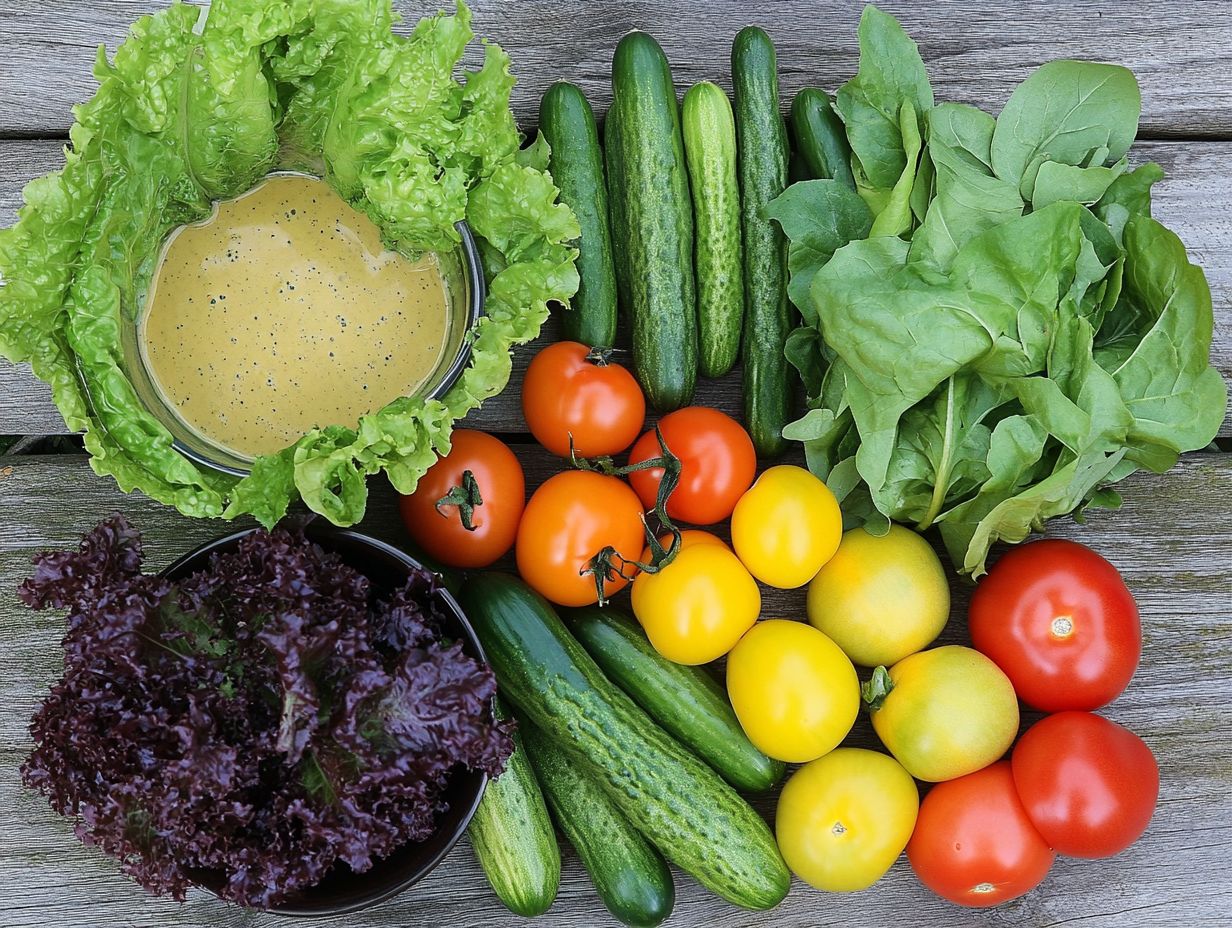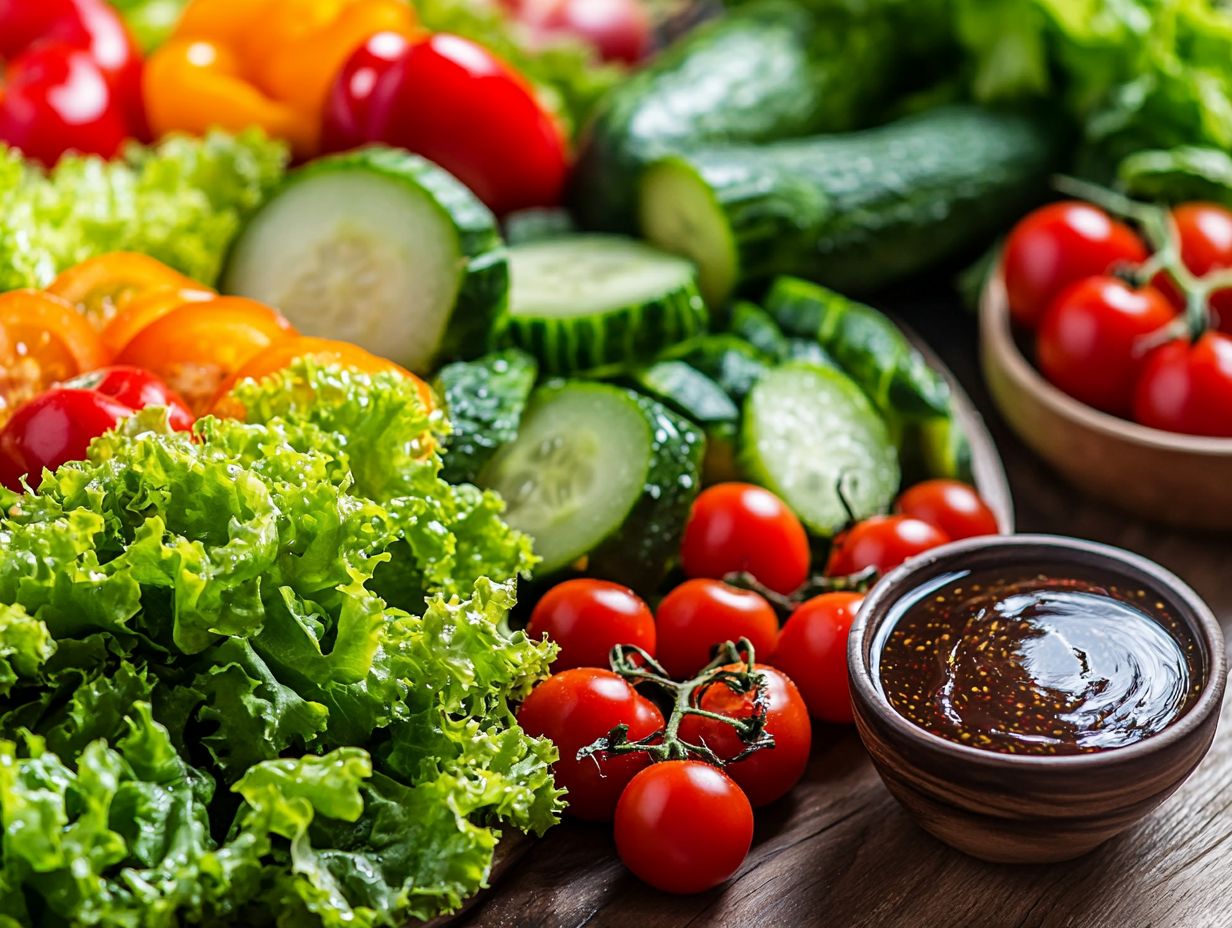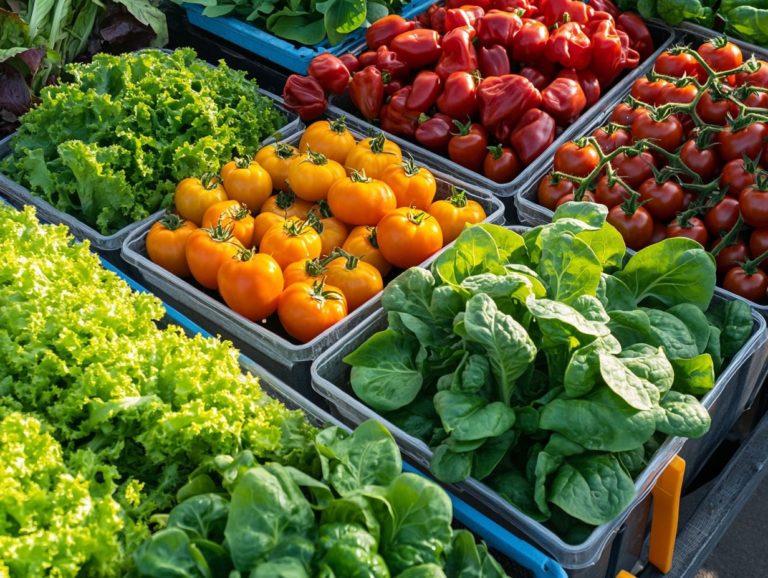“Best Hydroponic Vegetables for Fresh Salads”
Hydroponic gardening is revolutionizing the way you think about growing food. This soil-less method maximizes both space and efficiency.
Whether you re a seasoned gardener or just starting out, this guide provides you with the essentials of hydroponic vegetables, especially those perfect for fresh salads.
From selecting the best plants to setting up your own system, you ll uncover practical tips designed to enhance your gardening experience.
Dive in and discover how you can enjoy nutritious, home-grown greens all year round!
Contents
- Key Takeaways:
- What is Hydroponic Gardening?
- Choosing the Right Vegetables for Hydroponic Growing
- Top Hydroponic Vegetables for Fresh Salads
- How to Set Up a Hydroponic Garden for Salad Vegetables
- Tips for Maintaining a Successful Hydroponic Garden
- Frequently Asked Questions About Hydroponic Vegetables
- Frequently Asked Questions
- What are the best hydroponic vegetables for fresh salads?
- Why are hydroponic vegetables ideal for salads?
- How do I grow hydroponic vegetables for salads?
- What are the benefits of using hydroponic vegetables in salads?
- Can I mix different types of hydroponic vegetables in my salads?
- Are there any special storage or preparation techniques for hydroponic vegetables in salads?
Key Takeaways:

- Hydroponic gardening allows for fresh, nutrient-rich vegetables without soil.
- When choosing vegetables for hydroponic growing, consider space, light, and water requirements.
- Top vegetables for hydroponic salads include lettuce, spinach, and herbs like basil and cilantro.
What is Hydroponic Gardening?
Hydroponic gardening offers you an innovative way to grow plants without soil. It uses water with nutrients to deliver essential elements directly to the roots.
By utilizing systems like Tower Gardens, Aerogarden, or Click & Grow, you can cultivate a diverse array of crops from crisp lettuce and vibrant leafy greens to aromatic herbs throughout the entire year.
This method fosters robust plant growth and gives you greater control over environmental factors. It also reduces the risk of pest invasions. This sustainable choice appeals to both novice and seasoned gardeners alike.
Overview and Benefits
Hydroponic gardening presents a wealth of benefits that you won’t want to overlook. Imagine a pest-free environment and the luxury of enjoying continuous harvests of fresh, flavorful greens.
This innovative technique requires far less space than traditional methods, making it ideal for urban dwellers or anyone with limited outdoor areas.
With vertical gardens plants grown upwards to save space and compact systems, you can transform even the smallest corners of your home into productive growing zones.
Hydroponics significantly cuts down on water usage up to 90% less than conventional agriculture allowing you to grow nutritious food while being environmentally conscious.
This method enables you to cultivate healthy, organic greens year-round, free from seasonal constraints, ultimately enhancing your food security and promoting a sustainable lifestyle.
Choosing the Right Vegetables for Hydroponic Growing
Selecting the right vegetables for hydroponic growing is pivotal for achieving a bountiful harvest. Consider opting for crisp lettuce, nutrient-dense spinach, robust kale, and fragrant chives.
Each of these choices excels in different hydroponic systems and conditions, allowing you to cultivate a thriving garden with ease.
Factors to Consider
When selecting vegetables for your hydroponic garden, it’s essential to consider various factors, including the specific growing conditions and suitable water solutions.
Light requirements are essential, as different vegetables thrive under varying intensities. Each plant has unique nutrient needs that must be addressed for healthy growth.
Space is another crucial factor; vertical systems like Tower Gardens can maximize yield in compact areas. Aerogarden setups provide a compact solution that’s perfect for beginners.
Understanding these essential elements boosts your growth potential. By thoughtfully evaluating these considerations, you can ensure a successful hydroponic gardening experience.
Start your hydroponic garden today and enjoy fresh greens all year round!
Top Hydroponic Vegetables for Fresh Salads

For your fresh salads, consider incorporating some of the finest hydroponic vegetables. Crisp lettuce, zesty arugula, and crisp endive not only boast vibrant flavors but also offer impressive nutrient density. These ingredients can elevate any dishes you craft.
Nutritious and Flavorful Options
Nutritious and flavorful options for your hydroponic salad garden go far beyond just leafy greens. Imagine vibrant herbs, hearty kale, and even fruits like tomatoes and peppers that thrive in these systems.
You’ll discover a diverse array of hydroponic vegetables, from the familiar basil and cilantro to intriguing lesser-known varieties like inchoy and watercress. Each of these options brings unique tastes to your kitchen, enhancing your meals. These crops thrive beautifully in an environment designed for controlled nutrient delivery, promoting best growth and enhancing flavor concentration.
Using continuous harvest systems can maximize your yields while minimizing waste. Regular harvesting keeps your plants in prime condition, encouraging bushier growth and extending your harvesting period throughout the year. Imagine the satisfaction of a bountiful harvest!
How to Set Up a Hydroponic Garden for Salad Vegetables
Establishing a hydroponic garden for your salad vegetables demands a selection of essential supplies. You’ll need a smart hydroponic system, automatic lighting, and efficient water solutions to create the ideal growing environment for your plants.
Each component plays a crucial role in ensuring your garden thrives and delivers the freshest produce possible.
Equipment and Techniques
Effective equipment and techniques are essential for your success in hydroponic gardening, whether you’re using proper container gardening methods or investing in cutting-edge hydroponic systems designed to foster optimal plant growth.
Among the most popular systems, you’ll find Aerogarden and Gardyn, both crafted to simplify the growing process for everyone, from beginners to seasoned gardeners. These systems are incredibly versatile, accommodating a wide range of plants, from fragrant herbs to crisp leafy greens, making them perfect for home use.
Techniques like Nutrient Film Technique (NFT) a method where a thin stream of nutrients flows over the roots and Deep Water Culture (DWC) where roots are submerged in nutrient-rich water offer distinct advantages. These methods promote rapid growth and enhance plant health.
Understanding these hydroponic systems makes gardening easier and more enjoyable, optimizing both yield and the health of your plants.
Tips for Maintaining a Successful Hydroponic Garden
To ensure your hydroponic garden flourishes, it’s vital to implement strategic gardening tips. This approach guarantees optimal growth and creates a maintenance-free environment where your plants can thrive.
Ensuring Optimal Growth and Harvest

Ensuring optimal growth and a bountiful harvest in your hydroponic garden requires you to master meticulous nutrient management, maintain consistent water levels, and provide appropriate lighting tailored to your plants’ needs.
Each plant has unique nutrient requirements, which greatly influence its yield and overall health. Keeping water quality in check prevents root diseases and promotes nutrient absorption, ultimately boosting your plants’ vitality.
Adjusting light conditions not only supports photosynthesis but can also significantly impact flowering and fruiting for various species. By closely monitoring these factors, you can cultivate a thriving environment where your plants flourish, leading to abundant harvests and vibrant growth throughout your gardening journey.
Start your hydroponic garden today for fresher salads and healthier eating!
Frequently Asked Questions About Hydroponic Vegetables
Have questions about hydroponic vegetables? We cover everything from effective growing techniques to the best systems for beginners.
Common Concerns and Answers
Common concerns about hydroponic gardening include pest control, nutrient delivery systems, and maintaining an indoor garden. Addressing these issues can help you cultivate a flourishing garden and prevent frustration.
For pest management, consider using integrated pest management (IPM) strategies. These involve using natural predators and other methods to control pests without harming your plants.
A precisely calibrated nutrient delivery system ensures your plants get the right balance of essential nutrients. Regularly monitor environmental conditions, like humidity and temperature, to create an ideal atmosphere for growth.
With consistent care and informed practices, you can achieve great success in your hydroponic journey!
Frequently Asked Questions
What are the best hydroponic vegetables for fresh salads?
Great hydroponic vegetables for fresh salads include lettuce, spinach, kale, arugula, microgreens, and herbs like basil and cilantro.
Why are hydroponic vegetables ideal for salads?

Hydroponic vegetables grow in a controlled environment, free from soil contaminants. They can be harvested at peak freshness, making them perfect for salads.
How do I grow hydroponic vegetables for salads?
To grow hydroponic vegetables for salads, you’ll need a hydroponic system, nutrient solution, and seeds or starter plants. Follow your system’s instructions and monitor water and nutrient levels regularly.
What are the benefits of using hydroponic vegetables in salads?
Hydroponic vegetables burst with flavor, offer great texture, and pack a nutritional punch compared to conventionally grown produce. They also last longer, making them a great salad option.
Can I mix different types of hydroponic vegetables in my salads?
Absolutely! Mixing different hydroponic vegetables enhances flavors, textures, and nutrients, making your salads even more delicious and nutritious.
Are there any special storage or preparation techniques for hydroponic vegetables in salads?
Store hydroponic vegetables in the refrigerator with a damp paper towel or container to keep them fresh. Just rinse them before using to ensure they remain crispy and ready to eat.






